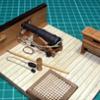-
Posts
5,950 -
Joined
-
Last visited
Content Type
Profiles
Forums
Gallery
Events
Everything posted by BANYAN
-
Thanks Roger
-
Hi Steven, the club built a model of Cerberus which is in the HMAS Castlemaine Museum now; I think this was as delivered. I have a few images and I am sure you are aware of the 'Save the Cerberus' web page which has a wealth of info? Looking forward to seeing your build. cheers Pat
-
Perhaps also worth considering this design for 'rocking' the vessel of sandbars or the mud in ports? (Many ships in shallow ports sat on the mud when the tide went out.) By shifting weight/cargo fore or aft would perhaps raise the keel sufficiently to get her off? But, I think this would have been an addition or complimentary outcome, rather than a design feature? cheers Pat
- 508 replies
-
That's a ripper find Keith. Thanks for sharing these photos which proved a great insight as to how these lamps were made and assembled. cheers Pat
-
This is one very nice model Eberhard, especially at the scale you are working. Kudos! cheers Pat
-
A very different subject for your next effort Greg; did all that rust attract you I have seen some info that suggested both guns may be removed to make-way for the installation of four 87-inch missile launcher modules, carrying up to 12 missiles. Which version are you building? cheers Pat
- 47 replies
-
- Zumwalt
- Snowman Model
-
(and 2 more)
Tagged with:
-
Some great research and discussion here - following with interest. Thanks guys. cheers Pat
- 508 replies
-
Interesting videos and info; thanks Isaiah. cheers Pat
-
Can't wait to see the planking going on this beauty; nice work Ian. cheers Pat
- 536 replies
-
- Quadrireme
- radio
-
(and 1 more)
Tagged with:
-
Hi Rick, I am sorry that I have not looked into your build before this - my loss as you are producing a very nice model. I have had a quick look through but will go back and read-in more carefully. Quite the task you have set yourself for a first model. That said, you appear to be well and truly up to the challenge. If you had not mentioned your issues with hull symmetry I would have never known, it looks fine in most photographs. I too like your shackles, they are very effective especially at scale 1/96. The deck furniture is coming along very well and looks great. For someone who claims they are not very good at joinery, you seem to be doing a very creditable job of it. You asked about sealing your deck? Once I have completed my deck planking, I mask/tape off the known deck furniture areas (outer boundary to allow glue to take) and give it as coat of Testors 'Dull Cote' which is a flat/matt varnish. I find this helps to protect the deck planking (especially as they are much lighter coloured planks), and should I accidently mark the planks doing other work, I can simply give it a light scrape to remove the marking and recoat the area. I use small scrapers made from old scalpel or similar blades for this. Being matt finish small touch-pups do not show. I am very much looking forward to your further updates. cheers Pat
- 351 replies
-
- Flying Fish
- Model Shipways
-
(and 1 more)
Tagged with:
-
That's a great outcome; and 'kudos' well deserved. cheers Pat
- 3,560 replies
-
- clipper
- hull model
-
(and 2 more)
Tagged with:
-
That great that Mike and his daughter were able to come and personally view your excellent work Rob; I'll bet they were as thrilled as you. cheers Pat
- 3,560 replies
-
- clipper
- hull model
-
(and 2 more)
Tagged with:
-

Archaeological Evidence for the Development of RN Gunnery
BANYAN replied to Steve20's topic in Nautical/Naval History
Thanks Steve, much appreciated. cheers Pat -
A wonderfully turned-out sectional model Dave; congratulations on her completion - it looks great! cheers Pat
- 143 replies
About us
Modelshipworld - Advancing Ship Modeling through Research
SSL Secured
Your security is important for us so this Website is SSL-Secured
NRG Mailing Address
Nautical Research Guild
237 South Lincoln Street
Westmont IL, 60559-1917
Model Ship World ® and the MSW logo are Registered Trademarks, and belong to the Nautical Research Guild (United States Patent and Trademark Office: No. 6,929,264 & No. 6,929,274, registered Dec. 20, 2022)
Helpful Links
About the NRG
If you enjoy building ship models that are historically accurate as well as beautiful, then The Nautical Research Guild (NRG) is just right for you.
The Guild is a non-profit educational organization whose mission is to “Advance Ship Modeling Through Research”. We provide support to our members in their efforts to raise the quality of their model ships.
The Nautical Research Guild has published our world-renowned quarterly magazine, The Nautical Research Journal, since 1955. The pages of the Journal are full of articles by accomplished ship modelers who show you how they create those exquisite details on their models, and by maritime historians who show you the correct details to build. The Journal is available in both print and digital editions. Go to the NRG web site (www.thenrg.org) to download a complimentary digital copy of the Journal. The NRG also publishes plan sets, books and compilations of back issues of the Journal and the former Ships in Scale and Model Ship Builder magazines.



